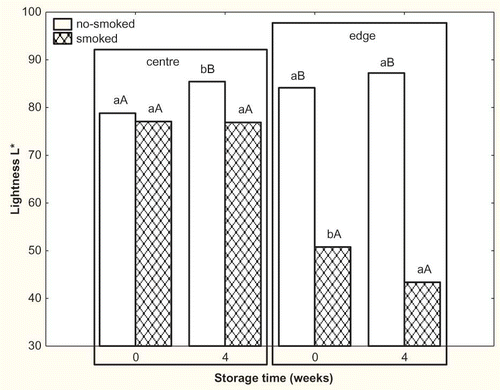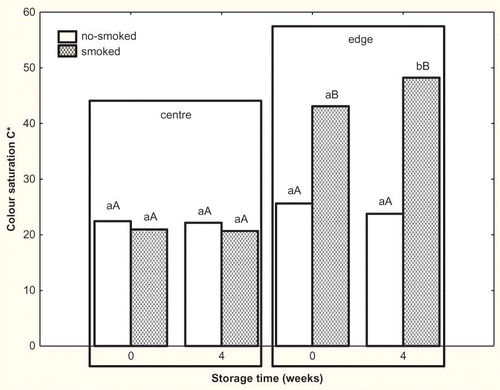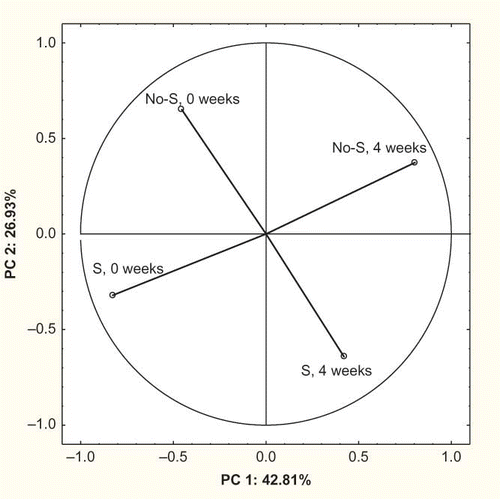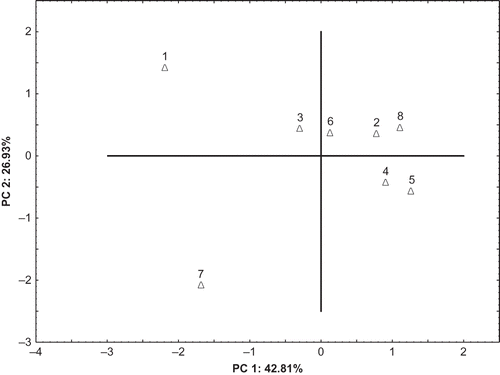Abstract
The smoking of cheeses contributes to significant changes in their color, aroma, and also content of free amino groups. The aim of the study was to evaluate changes in sensory attributes of smoked and unsmoked mozzarella cheese during storage for four weeks. It was found that inner layers of both cheeses were equally light despite large differences in their outer layers (ΔL*: 26.33 for smoked and ΔL*: 5.33 for unsmoked). Color of the edge layer in smoked cheese was more saturated than in unsmoked cheese (ΔC* = 17.47). The edge layer in smoked cheese after storage became more saturated (ΔC* = 5.12). Desirability of smoked cheese was 1.5-fold greater than that of unsmoked cheese. Smoking contributed to the disappearance of cooked aroma (by 32%), whey, and cowy/phenolic aromas and intensified the perceptibility of acid taste (8.5 times). Changes were higher in smoked mozzarella because of its higher proteolysis susceptibility.
INTRODUCTION
In the development of cheese-making a considerable role has always been played by the production of soft skinless rennet non-ripening cheeses. A typical representative of this group of cheeses is mozzarella cheese, produced traditionally from buffalo's or cow's milk. Frequently in many countries, particularly in Eastern and Central Europe, mozzarella cheese is additionally subjected to smoking. These cheeses are consumed as toppings for sandwiches or toasts, as snacks with wine or beer, and in catering. Thus an important technological aspect is connected with the proteolysis influence on sensory attributes of smoked cheese.
Controlling the type of the smoke-generating agent and conditions of its combustion in the course of smoking contributes to the production of cheeses differing in aroma as well as color and its intensity. All these changes could be affected by protein hydrolysis. Penetrability of smoke, constituting a mixture of phenols, ketones, aldehydes, and acids, is also dependent on the composition of cheese being smoked.[Citation1] Cheeses are smoked using smoke coming from combustion of hardwood, such as beech, cherry, or alder. There are some smoking technologies using smoke produced from oat straw. Smoking leads to sensory changes in cheese and to changes in its shelf life. In turn, the depth of smoke penetration determines the stability of smoked cheese.
The mean shelf life of mozzarella cheese is typically four weeks. However, it is also the time of further ripening of this cheese and quality changes.[Citation2 − Citation7] These changes affect sensory attributes of taste and aroma as well as parameters of color.[Citation8 − Citation11] The aim of this study was to evaluate parameters, such as changes in free amino groups, color, and aroma in mozzarella cheese subjected to the process of smoking and storage.
MATERIALS AND METHODS
Materials
Material for analyses comprised commercially available mozzarella cheeses, both natural and smoked, purchased in retail outlets throughout Poland. Cheeses came from different producers and from different production batches (n = 12). The mean shelf life of natural cheese, declared by producers, was 28 days, while that of smoked cheese ranged from 35 to 40 days. Cheese was offered in balls with unit weights ranging from 220 to 250 g. Cheeses were stored at 4 ± 1°C for four weeks. Measurements of cheese color were conducted on the inner layer of cheese from the geometrical centre of the ball and the edge layer of 2.5 cm deep.
Composition Analysis
Total nitrogen content by the Kjeldahl method was determined with the assistance of the Kjetec System 1026 apparatus of the Distilling Unit Tecator Company (Őrebro, Sweden). Water and fat contents in cheese were determined using standard methods.[Citation12] The pH of the examined cheeses was determined using a pH-meter (CP-315, Elmetron Co., Zabrze, Poland), which was equipped with a combined ESAgP-301W type electrode (Eurosensor Co., Gliwice, Poland), consisting of a glass half-cell and a saturated chloro-silver half-cell.
Assessment of Proteolysis
The water soluble extracts (WSE) were prepared according to the method of CitationKuchroo and Fox[Citation13] and their nitrogen content was determined using the macro-Kjeldahl method.[Citation14,Citation15] The concentrations of free amino groups in cheeses were determined by the Cd-ninhydrin method of CitationFolkertsma and Fox.[Citation16] A standard curve based on leucine was used to convert A507 to its leucine equivalent.
Color Analysis
The instrumental cheese color measurement was based on the value of the CIE Lab system coordinates, established by the International Commission on Illumination. The degree of color saturation, C*, was determined using the following formula: C* = [a2 + b2]0,5. Standardized cheese samples, the dimensions of which were: h = 25 mm, Ø = 34 mm, v = 12,000 μL, were put in an OG Hellma GmbH and Co. KG cuvette (Müllheim, Germany). The measurement was carried out with a D65 light source, the continuous spectrum of which in the visible range is the closest to daylight, and with a 10° observation angle, using an X-Rite SP-60 spectrophotometer (Grandville, USA). The spectrophotometer was calibrated based on the SP62-162 perfect black and white model (Grandville, USA). Sample temperature during the experiment was 10–12°C.
Sensory Analysis
Sensory analysis was conducted by the profiling method.[Citation17,Citation18] The panel comprised a team of 10 adequately trained individuals, prepared to perform sensory examinations.[Citation19 − Citation22] An intensity scale of 0 to 10 points was used (scale length of 110 mm), where 0 points denotes an undetectable aroma and 10 points very intense aroma. Cheese sample preparation was described by CitationBarcenas and others, 2001.[Citation23] In order to determine the position of tested samples in the perception space the results were evaluated using the principal component analysis (PCA) based on the NIPALS algorithm. Descriptors of attributes with their definitions and references are presented in .[Citation24] In the evaluation of overall desirability of samples, a hedonic scale was used with intensity ranging from 1 to 9 points; where 1 denotes an exceptionally desirable sample, 2 highly desirable, 3 desirable, 4 slightly desirable, 5 neither desirable nor undesirable, 6 slightly undesirable, 7 undesirable, 8 highly undesirable, and 9 exceptionally undesirable.[Citation25] Evaluated quality attributes included taste, aroma, appearance, color, and consistency. The evaluation of overall desirability was done by the group of 67 people.
Table 1 Descriptors of cheese subjected to sensory examination
Statistical Analysis
Statistical calculations were performed using a STATISTICA (version 7.1) data analysis software system by StatSoft, Inc. (2005).
RESULTS AND DISCUSSION
Based on the analyses, it was found that unsmoked and smoked mozzarella cheeses contained statistically identical amounts of protein (24.2%) and fat (17.2%). Smoked mozzarella cheese contained 66.44% water and it was by 7% less than in unsmoked cheese. Active acidity of smoked cheese (pH 4.46) was significantly greater (ΔpH = 0.06) than that of unsmoked cheese. After four weeks the initial difference in active acidity of both cheeses was retained, but values were on average lower by 0.07 pH units.
The performed analysis indicate that edge layer is more susceptible on proteolysis’ enzymes than center layer (). This result relates to smoked and unsmoked cheese. After four weeks level of WSE in cheeses was 3-fold higher in unsmoked cheese and over 4-fold higher in smoked cheese. Regardless of smoking the increase in free amino groups in cheeses was about 5-fold higher. During storage cheese's proteins were party or completely hydrolyzed to simple water soluble compound such as simple peptones, amino acids, and ammonia. The protein conformation into soluble form with average and high water content caused their softness and higher meltability. The harder a cheese is, means a lower amount of protein hydrolyzed.[Citation26,Citation27]
Table 2 The effect of the smoking process on proteolysis in different layers of mozzarella cheese in the course of storage
A significant difference (ΔL* = 33.39) in terms of lightness of color between unsmoked and smoked cheeses was shown only when measuring the outer edge layer (). Outer layers in the center of unsmoked and smoked cheeses were equally light. The outer layer, rather than the inner layer, turned out to be lighter (ΔL* = 5.33) in unsmoked cheese. An increased difference (ΔL* = 26.33) was found when measuring lightness in the layers of smoked cheese. However, in this case the inner layer was lighter. After four weeks, lightness of unsmoked cheese increased significantly irrespective of the analyzed cheese layer. In the case of smoked cheese, storage time did not change lightness of the cheese center, but it significantly reduced lightness of the edge layer (by 14.5%). Values of coordinates a* and b* influenced the value of the degree of color saturation C*, calculated for the analyzed samples (). Color of the edge layer in smoked cheese was more saturated than in unsmoked cheese (ΔC* = 17.47). The center of smoked and unsmoked cheeses had an equally saturated color. Storage did not change the degree of color saturation in the center and the edge layer in unsmoked cheese. Moreover, after four weeks no difference was observed in the saturation of color in the center of smoked cheese. However, color in the edge layer of smoked cheese after storage became more saturated (ΔC* = 5.12).
Figure 1 The effect of the smoking process on lightness of color L* (%) in different layers of mozzarella cheeses in the course of storage. a-b: different small letters denote a significant effect of storage time; A-B: different capital letters denote a significant effect of smoking for the same cheese layer, α = 0.05.

Figure 2 The effect of the smoking process on color saturation C* (-) in different layers of mozzarella cheeses in the course of storage. a-b: different small letters denote a significant effect of storage time; A-B: different capital letters denote a significant effect of smoking for the same cheese layer, α = 0.05.

Consumer preferences contributed to smoked mozzarella cheese being considered the most desirable (score of 8.7 points). Even after four weeks smoked cheese was 1.5 times more desirable than unsmoked cheese not subjected to storage. Unsmoked cheese after four weeks, in the opinion of the evaluating panel members, received scores for desirability as low as 1.3 points. At that time the score for desirability of smoked cheese decreased from 8.7 to 6.4 points.
The proteolysis level express with the amount of WSE and free amino groups is highly correlated with overall applicability of smoked and unsmoked cheese –0.737 ≤ r ≤ –0.998 (). Low value of correlation's coefficients among the proteolysis and color components L* and C* indicates that analyzed proteolysis factors depend on features other than color. Because of that result particular analysis of taste and aroma of mozzarella cheese was performed.
Scores for individual descriptors determined the variation of sensory quality in smoked and unsmoked cheeses, both immediately after production and after four weeks of storage. The effect of smoking and storage on quality of mozzarella cheese is confirmed by the PCA for PC 1 × PC 2 (). Smoking of mozzarella cheese contributed to the disappearance of cooked aroma (by 32%), whey aroma (by 53%), cowy/phenolic aroma (by 82%), waxy/crayon aroma (by 26%), and at the same time to the manifestation of acid taste (). Smoked cheese was 8.5 times more acidic than unsmoked cheese. However, this difference disappeared after four weeks of storage. In this case unsmoked cheese was more acidic (1.8-fold). Storage of smoked and unsmoked cheese contributed to the disappearance of cooked aroma. In both cheeses it was detectable at the same level. Storage also caused a reduction of smoked aroma detectability by over 50%. After four weeks, whey aroma was equally perceptible in unsmoked cheese, while in smoked cheese the same trend was found for waxy/crayon aroma. In the other cases evaluated aromas were intensified. The greatest increase was observed for the perception of free fatty acid aroma (3-fold in unsmoked cheese and as much as 9-fold in smoked cheese). The PCA for profiling results in case of aromas in natural and smoked mozzarella cheeses, irrespective of cheese storage time, showed that the greatest importance was found for smoked, cooked, cowy/phenolic, and acid aromas (). The smallest role in the evaluation of sensory quality was observed for sulfur and waxy/crayon aromas. The greatest convergence was shown when evaluating free fatty acid and cowy/phenolic aromas, irrespective of the type of cheese and its storage time.
Table 3 Coefficients (r) of correlations among the proteolysis and sensory characteristics of mozzarella cheeses
Table 4 Sensory analysis of aroma of unsmoked and smoked mozzarella cheese during storage
Figure 3 A biplot of the aroma profile in sensory examination of unsmoked and smoked mozzarella cheese in the course of storage, α = 0.05. No-S: unsmoked mozzarella cheese; S: smoked mozzarella cheese; 0 weeks: no storage; 4 weeks: after storage.

Figure 4 Principal component analysis for results of aroma profiling in unsmoked and smoked mozzarella cheese in the course of storage, α = 0.05. 1: cooked; 2: whey; 3: sulfur; 4: free fatty acid; 5: cowy/phenolic; 6: waxy/crayon; 7: smoked; 8: acid.

Wang and Sun[Citation28,Citation29] in tested mozzarella cheese determined 46.1% water and acidity of pH 5.37. A higher acidity was reported by Muthukumarappan and others[Citation30] when investigating commercially available unsmoked mozzarella cheese (from 4.96 to pH 5.16). Active acidity of mozzarella cheeses tested by CitationSheehan and others[Citation31] increased with an extension of storage time. CitationO'Reilly and others,[Citation32] when testing mozzarella cheese recorded 48.45% water content. The essence of the effect of water content on quality attributes of mozzarella cheese was shown in their study by CitationKindstedt and Guo[Citation5] and Hong and others.[Citation4]
CitationMerrill and others[Citation6] stated an increase in parameter b* from approximately 7.6 to 15.2 in the course of 28-day storage of mozzarella cheese. The higher the fat content found in the tested cheese was, the much lower was the increase recorded by the authors in the course of storage for parameter b*. CitationMatzdorf and others[Citation33] when analyzing color in mozzarella cheese measured L* = 60.6, a* = –2.8, and b* = 16.8. The higher the heating temperatures were for this cheese, the more lightness decreased to a value L* = 52.6, while parameter b* increased to 20.5. Cheese ripening during storage was the immediate cause of changes in color, which was shown by CitationSaldo and others[Citation34] and CitationKahyaoglu and Kaya.[Citation35]
CONCLUSION
Smoking of mozzarella cheese resulted in a reduction of its lightness and a greater saturation of color in the outer layer in comparison to the values in unsmoked cheese. Inner layers in smoked and unsmoked cheeses had an equally saturated color. As a result of smoking, whey and cowy/phenolic aromas disappeared in the tested cheese, but all the same time the detectability of acid taste increased. Differences in the perceptibility of acid taste between smoked and unsmoked cheeses disappeared with an extension of storage time. In the course of storage, the perceptibility of free fatty acid aroma in smoked cheese increased more than in unsmoked cheese. Irrespective of storage time smoked cheese was considered to be more desirable by the evaluating panel members than unsmoked cheese. The range of these changes depend on cheese proteolysis factors. These were higher in smoked than unsmoked cheese.
REFERENCES
- Adhikari , H. , Heymann , H. and Huff , H.E. 2003 . Textural characteristics of lowfat, fullfat, and smoked cheese: Sensory and instrumental approaches . Food Quality and Preferences , 14 : 211 – 218 .
- Barron , L.J. , Redondo , Y. , Aramburu , M. , Gil , P. , Perez-Elortondo , F.J. , Albisu , M. , Najera , A.I. , Renobales , M. and Fernandez-Garcia , E. 2007 . Volatile composition and sensory properties of industrially produced Idiazabal cheese . International Dairy Journal , 17 : 1401 – 1414 .
- Di Cagno , R. , Banks , J. , Sheehan , L. , Fox , P.F. , Brechany , E.Y. , Corsetti , A. and Gobbetti , M. 2003 . Comparison of the microbiological, compositional, biochemical, volatile profile, and sensory characteristics of three Italian PDO ewes’ milk cheeses . International Dairy Journal , 13 : 961 – 972 .
- Hong , Y.H. , Yun , J;J. , Barbano , M;D. , Larose , K;L. and Kindstedt . 1998 . P.S. Mozzarella cheese: Impact of three commercial culture strains on composition, proteolysis, and functional properties . Australian Journal of Dairy Technology , 53 : 63 – 169 .
- Kindstedt , P.S. and Guo , M.R. 1998 . A physico-chemical approach to the structure and function of mozzarella cheese . Australian Journal of Dairy Technology , 53 : 70 – 73 .
- Merrill , R.K. , Oberg , C.J. , McManus , W.R. , Kalab , M. and McMahon , D.J. 1996 . Microstructure and physical properties of a reduced fat mozzarella cheese made using Lactobacillus casei ssp . casei adjunct culture. Food Science and Technology , 29 : 721 – 728 .
- Romeih , E.A. , Michaelidou , A. , Biliaderis , C.G. and Zerfiridis , G.K. 2002 . Low-fat white brined cheese made from bovine milk and two commercial fat mimetics, physical, and sensory attributes . International Dairy Journal , 12 : 525 – 540 .
- Cais-Sokolińska , D. and Majcher , M. 2010 . Sensory properties and volatile composition of full and non-fat cheese produce from curd—ripened fried acid tvarog . Acta Alimentaria Hungary , 39 ( 1 ) : 69 – 80. .
- Fox , P.F. and Wallace , J.M. 1997 . Formation of flavor compounds in cheese . Advances in Applied Microbiology , 45 : 17 – 85 .
- Kowalska , E. , Cais-Sokolińska , D. and Lasik , A. 2010 . Colour changes of vacuum packed and in brine mozzarella cheese resulting from microwave heating before and after freezing . Polish Journal of Commodity Science , 6 ( 25 ) : 84 – 90 .
- Zalazar , C.A. , Zalazar , C.S. , Bernal , S. , Bertola , N. , Bavilacqua , A. and Zaritzky , N. 2002 . Effect of moisture level and fat replacer on physicochemical, rheological, and sensory properties of low fat soft cheeses . International Dairy Journal , 12 : 45 – 50 .
- 1995 . “ Food Composition ” . In Association of Official Analytical Chemists , 16th , USA : Additive, Natural Contaminants . AOAC Official Methods of Analysis 2ed
- Kuchroo , C.N. and Fox , P.F. 1982 . Soluble nitrogen in Cheddar cheese: Comparison of extraction procedures . Milchwissenschaft , 37 : 331 – 334 .
- Fox , P.F. 1989 . Proteolysis during cheese manufacture and ripening . Journal of Dairy Science , 72 : 1379 – 1400 .
- Singh , T.K. , Fox , P.F. , Hojrup , P. and Healy , A. 1994 . A scheme for the fractionation of cheese nitrogen and identification of principal peptides . International Dairy Journal , 4 : 111 – 122 .
- Folkertsma , B. and Fox , P.F. 1992 . Use of the Cd-ninhydrin reagent to assess proteolysis in cheese during ripening . Journal of Dairy Research , 59 : 217 – 224 .
- ISO 6564 Sensory analysis–Methodology–Flavour profile methods , Geneva , Switzerland : International Organization for Standardization .
- ISO 6658 Sensory analysis–Methodology–General guidance , Geneva , Switzerland : International Organization for Standardization .
- Abdel-Hamid , L.B. , El-Shabrawy , S.A. , Awad , R.A. and Singh , R.K. 2000 . Physical and sensory characteristic of processed Ras cheese spread with formulated emulsifying salt mixtures . International Journal of Food Properties , 3 : 15 – 36 .
- Barcenas , F.J. , Perez-Elortondo , F.J. and Albisu , M. 2000 . Selection and screening of a descriptive panel for ewes milk cheese sensory profiling . Journal of Sensory Studies , 15 : 79 – 99 .
- ISO 3972 Sensory analysis–Determination of sensitivity of taste , Geneva , Switzerland : International Organization for Standardization .
- ISO 5496 Sensory analysis–Methodology–Initiation and training of assessors in the detection and recognition of odours , Geneva , Switzerland : International Organization for Standardization .
- Barcenas , F.J. , Perez-Elortondo , F.J. , Salmeron , J. and Albisu , M. 2001 . Sensory profile of ewe`s milk cheeses . International Food Science and Technology , 7 : 347 – 353 .
- Drake , M.A. , McIngvale , S.C. , Gerard , P.D. , Cadwallader , K.R. and Civille , G.V. 2001 . Development of a descriptive language for Cheddar cheese . Journal of Food Science , 66 : 1422 – 1427 .
- ISO 4121 Sensory analysis–Methodology–Evaluation of food products by methods using scales , Geneva , Switzerland : International Organization for Standardization .
- Awad , S. 2006 . Texture and flavour development in Ras cheese made from raw and pasteurised milk . Food Chemistry , 97 : 394 – 400 .
- Fernandez , M. , Singh , T.K. and Fox , P.F. 1998 . Isolation and identification of peptides from the diafiltration permeate of the water-soluble fraction of Cheddar cheese . Journal of Agricultural and Food Chemistry , 46 : 4512 – 4517 .
- Wang , H. and Sun , D. 2002 . Melting characteristics of cheese: Analysis of effect of cheese dimensions using computer vision techniques . Journal of Food Engineering , 52 : 279 – 284 .
- Wang , H. and Sun , D. 2004 . Evaluation of the oiling off property of cheese with computer vision: Influence of cooking conditions and sample dimensions . Journal of Food Engineering , 61 : 57 – 66 .
- Mathukumarappan , K. , Wang , Y.C. and Gunasekarant , S. 1999 . Short communication: Modified Schreiber test for evaluation of mozzarella cheese meltability . Journal of Dairy Science , 82 : 1068 – 1071 .
- Sheehan , J.J. , Huppertz , T. , Hayes , M.G. , Kelly , A.L. , Beresford , T.P. and Guinee , T.P. 2005 . High pressure treatment of reduced-fat mozzarella cheese: Effects on functional and rheological properties . Innovative Food Science and Emerging Technologies , 6 : 73 – 81 .
- O´Reilly , C.E. , Murphy , P.M. , Kelly , A.L. , Guinee , T.P. , Auty , M.A.E. and Beresford , T.P. 2002 . The effect of high pressure treatment on the functional and rheological properties of mozzarella cheese . Innovative Food Science and Emerging Technologies , 3 : 3 – 9 .
- Matzdorf , B. , Cuppet , S.L. , Keeler , L. and Hutkins , R.W. 1994 . Browning of Mozarella cheese during high temperature pizza baking . Journal of Dairy Science , 77 : 2850 – 2853 .
- Saldo , J. , Sendra , E. and Guamie , B. 2005 . Colour changes during ripening of high pressure treated hard Caprine cheese . High Pressure Research , 22 : 659 – 663 .
- Kahyaoglu , T. and Kaya , S. 2005 . Effect of fat reduction and curd dipping temperature on viscoelasticity, texture, and appearance of Gaziantep cheese . Food Science and Technology International , 11 : 191 – 198 .
